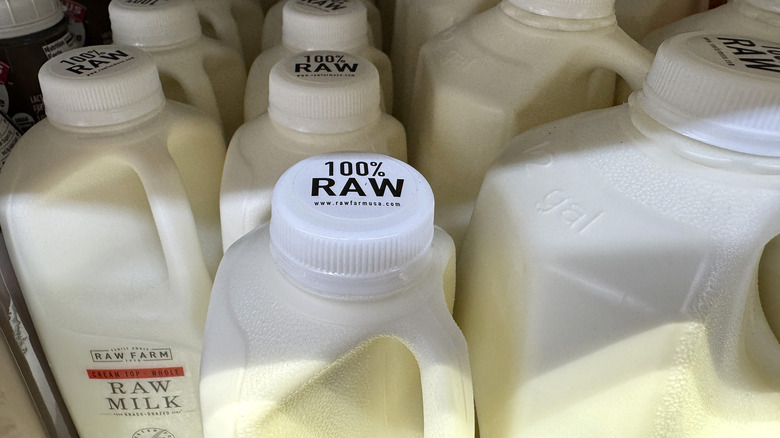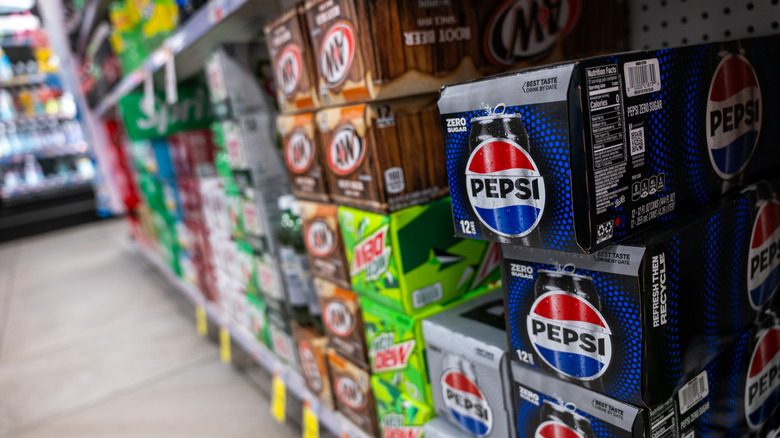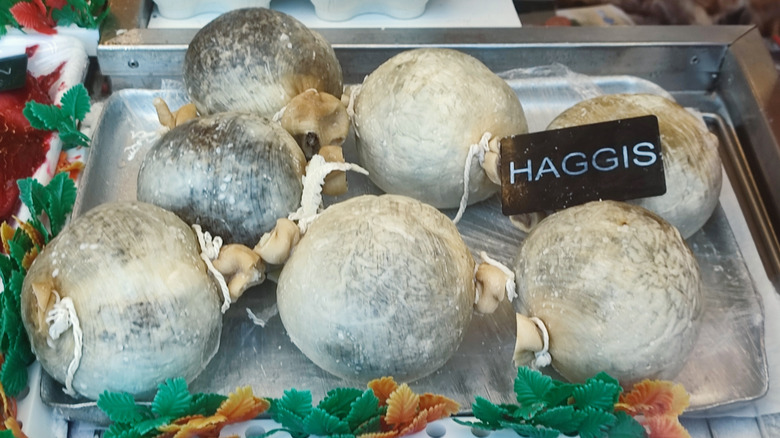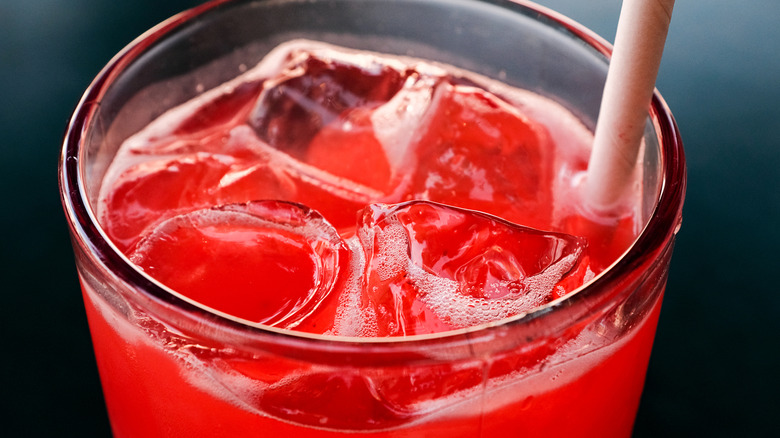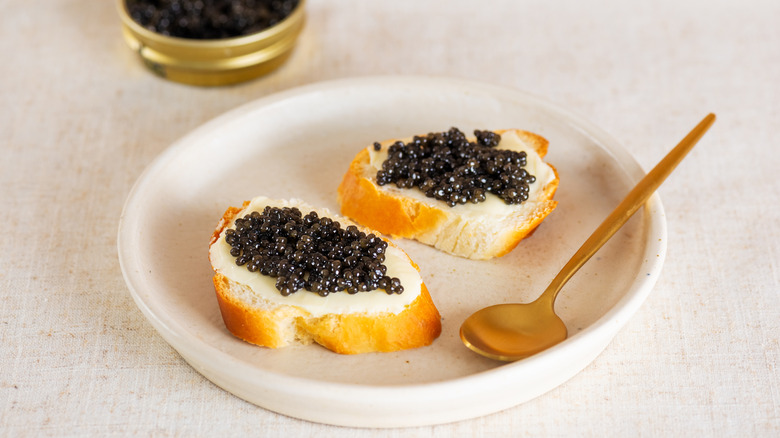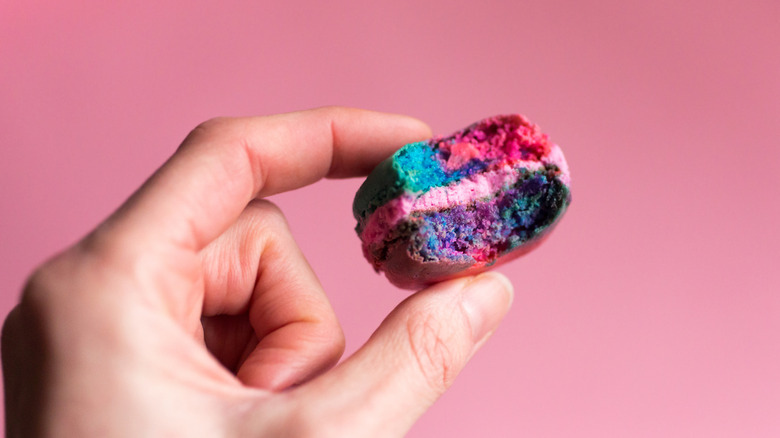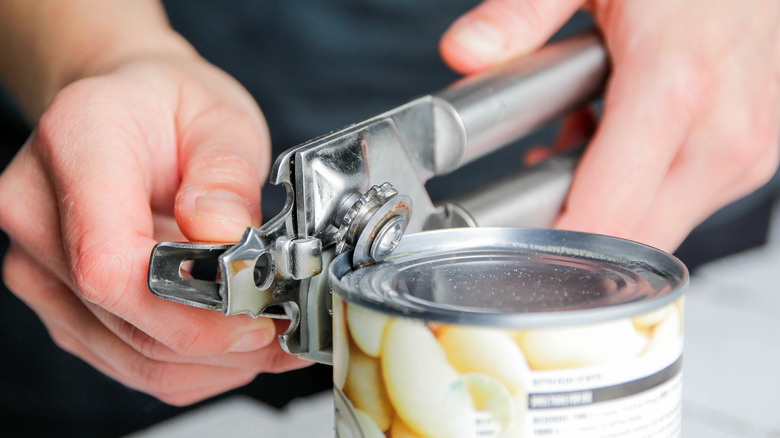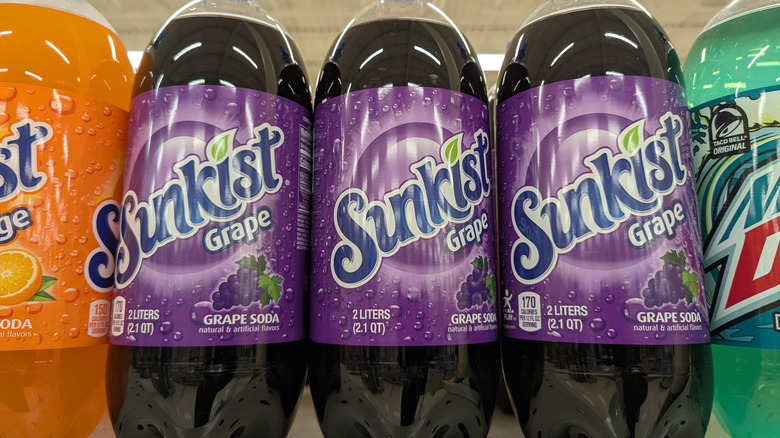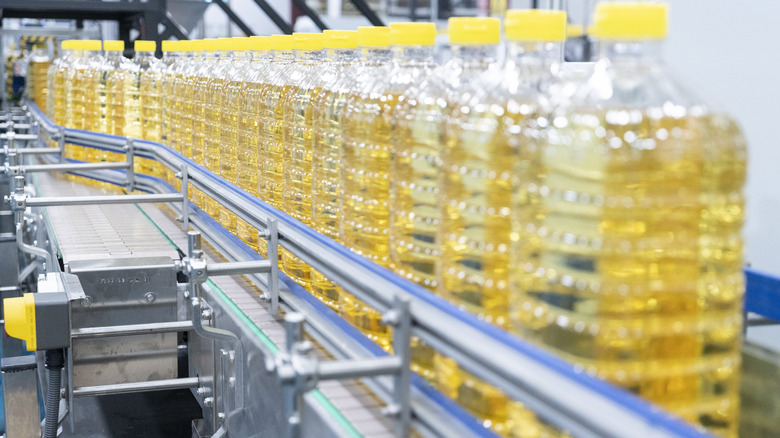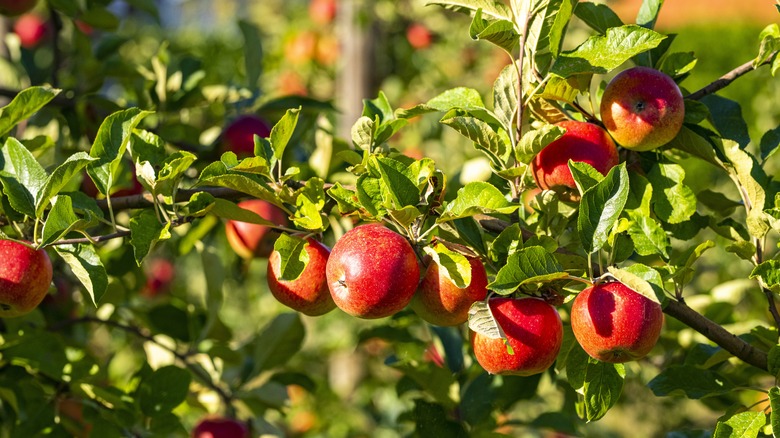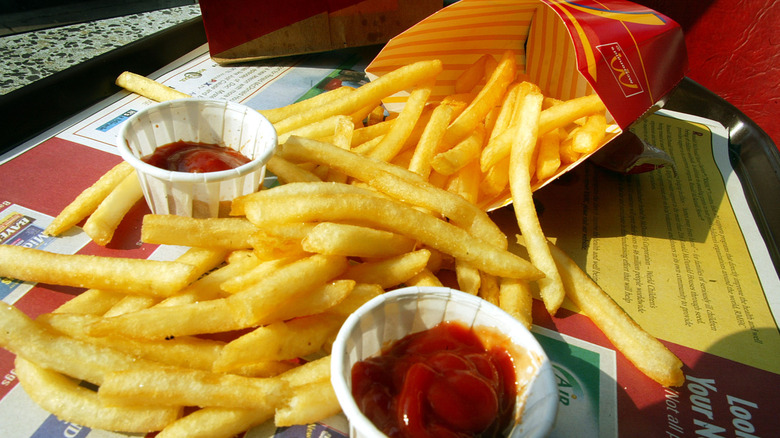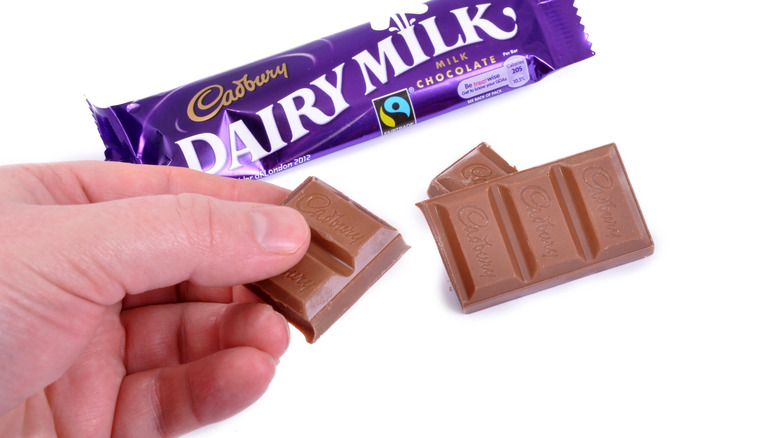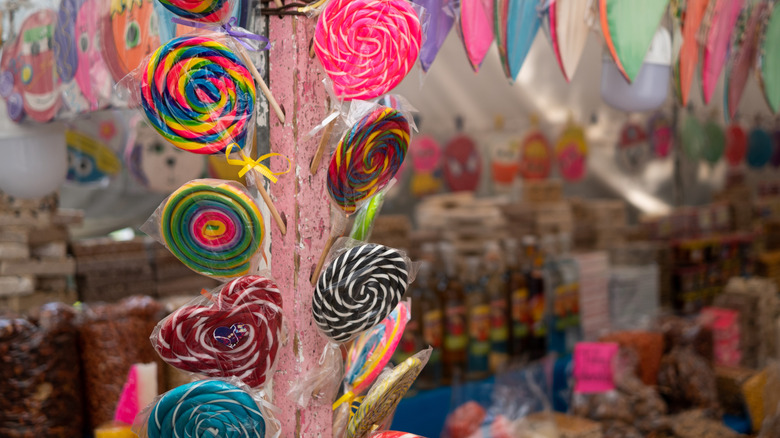Foods And Additives From The 1970s And 1980s That Are Banned Today
When you think back to 40 or 50 years ago (yes, that's how far away we are from the 1970s and 1980s!), what kind of foods come to mind? Do you imagine vintage recipes for foods like fondue or slightly sus casseroles? Or do you reminisce over old-fashioned desserts like Watergate salad or Jello salad?
Whatever comes to mind, if you were to stroll through a grocery store or even just peek into a pantry from the 1970s or 1980s, you'd probably notice a few key differences. Since then, the United States government has taken a greater interest in what goes into and on our food, as well as the food we're eating, generally. As such, there are a handful of foods and additives from the 1970s and 1980s that are banned today. You may be able to find them in other countries, if you really want to try them — but some are downright dangerous and better left alone.
Raw milk
Raw milk certainly is a divisive topic. Raw milk — or milk that's not been pasteurized in order to kill pathogens — was once all there was and, even after pasteurization became popularized, raw milk was still a beloved food on the fringes. However, the U.S. government takes a strong stance on raw milk. The U.S. Food & Drug Administration (FDA) cites the dangers of raw milk consumption and notes that raw milk does not cure lactose intolerance, asthma, or allergies, or is otherwise good for your health.
Bans on raw milk can be traced back to the early 20th century, when New York City became the first place to require milk pasteurization in 1910. Bans on the sale of raw milk continued in varying degrees, and, finally, in 1973, a federal judge banned the interstate sale of raw milk. Now, states have their own laws surrounding the sale or ban of raw milk, meaning it isn't so easy to buy in your neck of the woods the way that it might've been in those brief early years of the 1970s.
Cyclamate
You probably don't recognize cyclamate by name, but this artificial sweetener came on the scene in the 1950s. The sweetener contained no calories, but was up to 40 times sweeter than actual sugar. It also was very stable and water soluble, so perfect for adding to a wide range of foods, gradually making its way into millions of American homes in the form of sodas, salad dressings, and other highly processed foods.
You only had a short amount of time in the 1970s to get your hands on some cyclamate-sweetened foods. The same year, the United States government banned the additive after animal studies suggested that cyclamate could cause cancer. Since that time, more studies have shown that perhaps cyclamate doesn't directly cause cancer, but it's still dangerous and can increase your chances of developing cancer in other ways. Oddly, cyclamate is still legal in the European Union, though some European governments highly recommend not eating over a certain amount of cyclamate per day.
Lung meat
Lung meat? You may immediately think, "Ew, why would I have even wanted to eat lung meat?" — but have you heard of haggis? This traditional Scottish dish contains the spongy organ, meaning traditional haggis is banned within the United States. Much like cyclamate, you would've needed to get your hands on "real" haggis quickly in the 1970s, as the U.S. Department of Agriculture forbade the sale of lung for human consumption in 1971.
So what's the big deal about eating lung? In the United States, while not necessarily wildly popular, it's still not unheard of to eat offal such as liver, heart, kidney, tongue, and brain, so why is lung so bad? The theory is that lungs, which are not often cooked to well done, could pass on dangerous microorganisms and trapped pollution that the animal had inhaled while alive, to the eater. Additionally, during processing, stomach contents can move from the animal's stomach into their lungs, and that can further make the lungs unfit for consumption.
Red No. 2 and Red No. 4
Red No. 3 isn't the only red food dye that's been banned in modern history. While this additive met the chopping block in 2025, Red No. 2 and Red No. 4 were kicked out of American diets in 1976. At the time of Red No. 2's banning, it was estimated that millions of Americans were consuming it on a daily basis, with, up until that point, the U.S. government claiming that Red No. 2 had undergone ample testing and that there was no proof that Red No. 2 caused cancer. As such, Red No. 2 had been incorporated into $10 billion worth of food, accounting for $4 million worth of food dye sales. It was primarily used in soft drinks and similar beverages, but also in everything from pet food to ice cream, sausage to cereal, maraschino cherries to cosmetics.
However, new evidence came to light that showed that Red. No. 2 could cause cancer in rats and so it was banned in 1976. As for Red No. 4, it was used in candy manufacturing, among other uses, but it was found that it could likewise cause negative health effects, namely urinary bladder polyps and adrenal gland atrophy.
Imported beluga caviar
Anyone wanting to serve caviar at their posh party in the 1970s or 1980s may've very well reached for Beluga caviar. For centuries, Beluga caviar has been in high demand, considered the height of luxury, particularly Russian Beluga caviar. However, all that love for Beluga caviar came with a downside: the Beluga sturgeon was heavily overfished and became critically endangered. As such, today and as of 2005, the United States overwhelmingly bans the sale and import of both the fish and the eggs. If you do want to try Beluga caviar, you just have one place in the country to (legally) get it: U.S. Sturgeon AquaFarms, which received a special exemption from the U.S. government in 2016 to sell sturgeon caviar.
Additionally, unfortunately, while the United States banned selling beluga caviar two decades ago, it hasn't changed the beluga sturgeon's status as a critically endangered species. As of 2019, the International Union for Conservation of Nature still listed the fish as such.
Violet No. 1
It's not just red dyes that you have to watch out for. Violet No. 1 was another food dye that you could find in foods in the early 1970s — before the United States banned the artificial coloring in 1973. Prior to that, Violet No. 1 had been uniquely used not to give candies a vibrant purple hue, as you might expect, but rather to stamp beef after U.S. Department of Agriculture inspection. However, studies found that Violet No. 1, like many other dyes of the same ilk, could cause cancer.
Up until 2025, if someone wanted to give their food a purple tint — such as if they're making some very jarring violet ketchup — they'd typically use a mixture of Red No. 3 and Blue 1, but with Red No. 3 being banned, that combination is no longer an option. One all-natural option is anthocyanin, which is found naturally in fruits such as grapes, blueberries, and cranberries, but in May 2025, the U.S. Food and Drug Administration also approved three new natural food colorants, one of which can be used to create bright purple colors: butterfly pea flower extract. The extract is already permitted for use in certain foods, such as alcoholic beverages and yogurt, but the recent approval extends its use to snack foods.
Lead-sealed canned goods
When popping open your favorite canned pantry items, do you ever stop to think what exactly holds the can together? Well, if you'd purchased that can of beans or canned corn in the 1970s or 1980s, it would have possibly been held together with lead solder. In the 1990s, the United States banned the use of lead solder for food cans, though, as it's not really safe for any amount of lead to come into contact with your food. As such, today, manufactures produce cans from steel and possibly tin, and weld them together at the seams rather than using the past's lead solder.
That said, you may still find lead in your canned items, unfortunately. The tin sometimes used in cans can contain lead if the tin has been contaminated or if the tin is a lead-containing alloy. One study conducted by the Environmental Defense Fund actually found that, after sampling more than 240 cans of food, about half showed detectable lead, while 98% of the tested 70 cans of fruit showed detectable lead.
Cinnamyl anthranilate
Cinnamyl anthranilate is a synthetic, artificial flavoring additive that was banned in the 1980s, as it was believed that it could cause cancer. Up until that point, though, it had been used for about 50 years, giving a grape or cherry flavor to various food items, including beverages, candy, and desserts. It also appeared as an additive in non-food items like soap and cosmetics, for its aromatic properties.
Now, manufactures have to use similar but deemed-safer artificial flavors or similar natural compounds to achieve a fake grape or cherry flavor. For example, methyl anthranilate is often used as a grape flavoring or to give cosmetics and similar products a grape scent. However, while this ingredient is permitted in the food industry, the Environmental Working Group does caution that its use in cleaning products poses a moderate level of concern as far as cancer risk goes, and notes that it can cause serious skin and eye irritation as well.
Brominated vegetable oil
Yes, you can buy vegetable oil at the grocery store and it's certainly not banned across the board — but one very specific type of vegetable oil has joined the ranks of federally banned ingredients, and that vegetable oil is brominated vegetable oil, or BVO. BVO was very recently banned, in 2024, but it was in the 1970s that the FDA seriously considered the GRAS (generally recognized as safe) status of BVO. Brominated vegetable oil is simply vegetable oil modified with bromine. Bromine is a naturally occurring element retrieved from the earth and water, and that's used for treating water, creating flame retardant fabrics, and photography. It can also be found in pesticides, fumigants, plastics, and dyes — but now it can't be found in your food.
Previously, BVO had been used as a fruit flavoring stabilizer in beverages, and had been since the 1920s. However, the question of BVO's safety had been brought up for decades and studies have shown that BVO causes negative health effects related to the thyroid in rats and pigs.
Asbestos-filtered booze
You probably are well aware of all the health problems that come with asbestos. Many think of asbestos as a slightly scary, flame-retardant material that appeared just about everywhere in construction for a brief time in history, and that some homeowners are still dealing with today, paying quite a lot for its removal. However, if you were drinking beer or wine in the 1970s, you could've been drinking your asbestos, too.
Asbestos was used throughout the alcoholic beverages industries to filter out impurities from the beverage. While numbers were higher in the early 1970s, in 1979, 30% of wine producers, 10% of beer producers, and 25% of other distillers were still using asbestos in their production processes (via Mesothelioma.com). Luckily, this practice stopped in the 1980s, but using these asbestos filters, which needed to be changed regularly, not only impacted the products themselves, but also the workers actively using the filters in breweries, wineries, and distilleries.
Alar-treated apples
Alar is a growth regulator that was applied to apple trees in the 1970s and 1980s. The chemical kept the apples from falling off the tree too soon. Unfortunately, these Alar-treated apples came with a big downside. In 1989, a study from the Natural Resources Defense Council named Alar as one of the chemicals that not only popped up very frequently in small children's diets, but also one of the chemicals that put children at the greatest risk of cancer.
This argument was not a new one, though. Alar had been investigated on a large scale multiple times in the 1970s and 1980s, and some of these investigations had found that Alar was very likely a carcinogen. Still, a nationwide ban didn't occur at that time. Instead, small-scale bans took place at the state and even brand level. Gerber and Mott's both stopped using Alar-treated apples. Maine and Massachusetts banned its use if the apples were going to be specifically used to create baby food. Finally, after a 1989 "60 Minutes" expose on the topic, public outcry increased, apple sales plummeted, and the Environmental Protection Agency banned its use.
Artificial trans fat
You can still find trans fat in a variety of foods, even though the American Heart Association recommends reducing trans fat consumption as much as possible. However, one thing you should no longer find? Artificial trans fat.
Manufacturers create artificial trans fat when they add hydrogen to liquid vegetable oils (natural trans fat, in contrast, come from dairy and meat). In 2015, though, the U.S. Food and Drug Administration finally said that artificial trans fats were no longer regarded as safe, and that food manufacturers could not sell partially hydrogenated oil, aka trans fat. Prior, this oil and its artificial trans fat had been used as a butter or lard replacement in food manufacturing and production, since the early 20th century, as a way to cut down on costs. Additionally, since the trans-fatty oil can be used multiple times in deep fryers, restaurants were likewise using it to similarly reduce costs and increase food production efficiency. Unfortunately, trans fat is bad for your cholesterol and heart health, and has been connected to certain cancers.
Authentic Cadbury chocolate
If you think this one can't possibly true, because you've purchased Cadbury chocolates plenty of times, you might just be shocked to find out that the Cadbury you're buying at Target or Walmart isn't the same Cadbury that you'd buy across the pond. It's not even the same recipe. American Cadbury chocolate contains less fat and a higher percentage of sugar, while British Cadbury chocolate has more fat and no preservatives. So, don't even try to buy an authentic Cadbury chocolate unless you're willing to also book a flight.
In this instance, it's not the federal government inflicting a ban on a food item. The enforcer is, though, a pretty powerful brand: Hershey. In 1988, Hershey acquired the right to make and sell all Cadbury products state-side. However, while Hershey would brand the chocolate under the Cadbury name, it would use its own recipes. The brand is absolutely not afraid to enforce this ban, either. In 2015, a lawsuit arose in which Hershey went after a company importing Cadbury chocolate from Britain to sell on American soil, stating that the company was infringing on its rights.
Candy containing lead
The FDA enforces a limit on lead in food items likely to be consumed by small children, such as candy, but these enforcements didn't start to come about until studies were conducted in the 1970s and 1980s that showed adverse effects of lead consumption in children, prompting the government to investigate further. The FDA wasn't specifically concerned with lead in candy until 1994, though, when California discovered imported candy from Mexico contained high amounts of lead that had leached from the candy's packaging.
Unfortunately, while the FDA has stepped in to monitor lead stateside, the issue of lead-containing candy crossing international borders is an ongoing problem. In 2001, the FDA said it had tested imported tamarind Bolirindo lollipops and found lead concentrations of 21,000 parts per million. For context, the FDA's limit on lead in candy is 0.1 parts per million. In 2004, the issue came up again, regarding tamarind and chile-coated candy. News reports of officials finding lead-containing candy was making headlines as recently as 2018.

